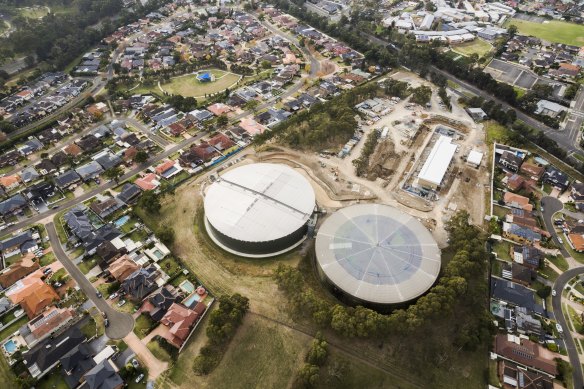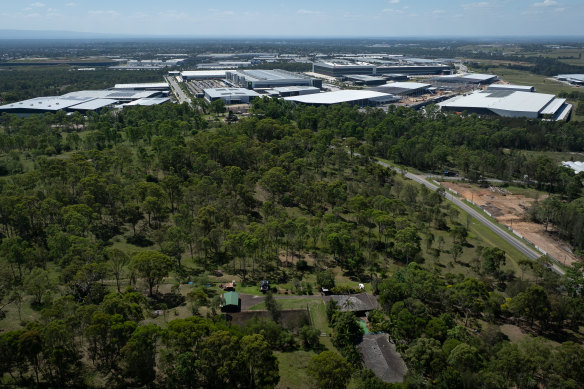This was published 5 months ago
‘We went berko’: How water is imperilling Sydney’s vaunted aerotropolis
Days before Christmas, the acting minister for water, Steve Whan, signed a ministerial order directing that Sydney Water could charge no more than $800,000 per hectare for stormwater connections at the sprawling Mamre Road industrial precinct in the city’s outer west.
Unsurprisingly, it wasn’t front-page news. But the behind-the-scenes intervention was one of the first signs the Labor state government was prepared to push back against Sydney Water – which it had vowed to protect from privatisation – on behalf of aggrieved developers.

Western Sydney Airport, pictured in August, is taking shape and due to open to passenger services in 2026.Credit: Wolter Peeters
In making Western Sydney Airport a success, the airport itself may turn out to be the easy part: it will open in just two years. Transforming thousands of hectares of the surrounding landscape into a functioning aerotropolis is proving a tougher challenge.
The state-owned corporation Sydney Water is central to that because it has to connect the major stormwater infrastructure. As in south-west Sydney, plenty of stakeholders are irked about how that’s proceeding and what they’re being asked to pay.
In June, Premier Chris Minns stepped in by tasking Infrastructure NSW boss Tom Gellibrand with co-ordinating infrastructure delivery across the aerotropolis and western Sydney. Minns did not mention water in his announcement, but for Gellibrand, it quickly became a focus.
“I’m not too worried about electricity in terms of the aerotropolis longer term, that’s a fairly straightforward exercise,” he told an industry function two weeks ago. “But provision of water, wastewater and stormwater services in the aerotropolis is a huge task for Sydney Water. They’ve got a lot of ground to cover.”
Indeed, the dimensions are staggering: the Mamre Road Precinct alone is 850 hectares, while the broader Western Sydney Aerotropolis consists of 11,200 hectares of rezoned land. Given Sydney’s shortage of serviced industrial land – described by analysts as a “silent crisis” – it stands to be an important economic injection.
But only if the pipes get connected.
Who pays?
A key reason developers are furious about Sydney Water is that they are now required to start paying water infrastructure contributions to help cover the cost of the enormous infrastructure pipeline required to service growth across the sprawling Sydney, Hunter and Illawarra mega-region.
The charges were reintroduced by then-Liberal treasurer Matt Kean in October 2022 to “support customers and improve the efficiency of infrastructure and housing delivery”. They had been set to zero by Labor in 2008.

A new pumping station in Cecil Hills was switched on in 2023 to help service Sydney’s growing south-west.Credit: Brook Mitchell
As the Independent Pricing and Regulatory Tribunal says, it means that for the past 15 years, the cost of new water, sewer and stormwater infrastructure “has not been recovered from developers, but from all water customers through quarterly bills” – as in, from households and businesses.
That includes massive projects such as the Upper South Creek Advanced Water Recycling Centre in Kemps Creek, due for completion in 2026.
Kean ordered the developer levies to be phased back in from July 1, 2024, except for stormwater charges, which began right away.
Urban Taskforce chief executive Tom Forrest, a former Labor chief-of-staff, says the charges are “effectively a tax on jobs in western Sydney [and] a tax on housing supply”. He argues they were brought back in anticipation of privatising Sydney Water, despite protestations to the contrary.
Either way, the absence of developer levies for more than 15 years plays a significant part in the debate – detailed in the Herald on Monday – over the backlog in water infrastructure to support Sydney’s housing and growth agenda.
The levies are now in place, subject to a patchwork of IPART-approved “development service plans” across the Sydney basin. Developers must pay 25 per cent of the maximum rate this year, rising to 50 per cent in 2025-26 and 100 per cent the following year.
Forrest says the initial rates proposed by Sydney Water ranged from $5000 per lot to $90,000 (in 2008, the average was $12,500). “When we went berko [berserk], they suddenly decided they had more capacity. Some of them went down by a hell of a lot,” he says.
“The kneejerk reaction from Sydney Water is to say there’s no capacity. It’s only if you ask 35 more times that you get a different answer.”
That’s a familiar refrain among Sydney Water’s critics. When Edgecliff in Sydney’s inner east was left out of the state government’s program to increase density around train stations, Planning Minister Paul Scully said it was because the area lacked water and sewer capacity.
Sydney Water’s general manager for asset lifecycle, Paul Plowman, says that’s not actually the case but acknowledges the company’s initial advice to the government was that it had no idea.
“The thing in Edgecliff was there wasn’t a lot of existing development proposed,” he says. “We didn’t have our models ready to go. Our advice was, ‘We just don’t know’. I can’t really speak for other people and how they interpreted that. I suspect it was interpreted as not having capacity.”
Sydney Water updated its advice on Edgecliff a month later, in September 2023, confirming there was sufficient capacity. But the government excluded the suburb from the program anyway.
In a statement, Sydney Water said the reintroduction of developer contributions would ease the financial burden on its customers and ensure their bills remained affordable as the city grows.
In the aerotropolis and its new city of Bradfield, developers would pay for 90 per cent of the new stormwater infrastructure, 66 per cent of wastewater and 15 per cent of drinking water, Sydney Water said.
The share of new water and wastewater infrastructure paid for by developers is expected to grow from 15 per cent in 2024-25 to 60 per cent in 2026-27.
Circuit breaker
Back on Mamre Road, Sydney Water initially wanted to charge developers $1.3 million per hectare for stormwater. According to the Mamre Road Landowners Group, this was “a complete shock to industry”, coming after a 2022 government paper indicated the likely charge would be $287,000 a hectare.

Industrial development, as seen from Kemps Creek.Credit: Wolter Peeters
Water Minister Rose Jackson ultimately decided to set the price at $800,000 just before Christmas because “we could not get a landing that worked”. The order said government intervention was warranted by the exceptional circumstances, including Sydney’s shortage of industrial land, the urgency of the airport opening and that Sydney Water’s proposed price “would have made the development less feasible”.
The government also commissioned IPART to review stormwater charges in the Mamre Road precinct, which is under way.
In a submission to that review, the landowners’ group, which controls about 70 per cent of the precinct, warned: “Industry simply cannot afford to continue investing into the Mamre Road Precinct or aerotropolis unless a reasonable and cost-effective solution is provided, which has serious consequences for the NSW economy and residents of Sydney.”
Tom Gellibrand, the bureaucrat tasked with solving the infrastructure delivery conundrum at the aerotropolis, admits he doesn’t have a “circuit breaker” for Sydney Water.
“To be completely open, I actually don’t have the answer,” he told a Property Council lunch in August. He suggested IPART, more regulation and empowering developers to do more work on Sydney Water’s behalf would all be part of the solution. “This is 11,000 hectares that we need to get up and running. It’s going to take a while.”
Start the day with a summary of the day’s most important and interesting stories, analysis and insights. Sign up for our Morning Edition newsletter.